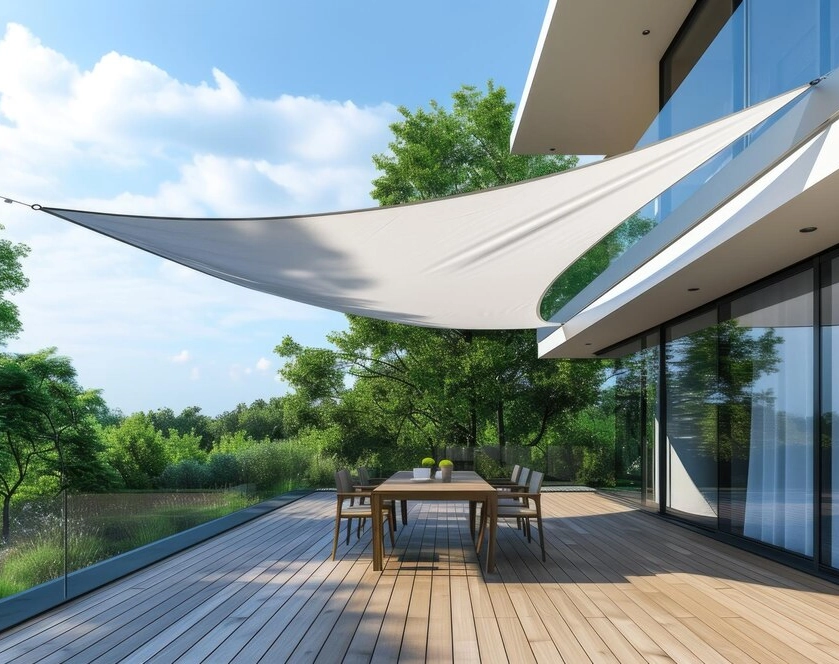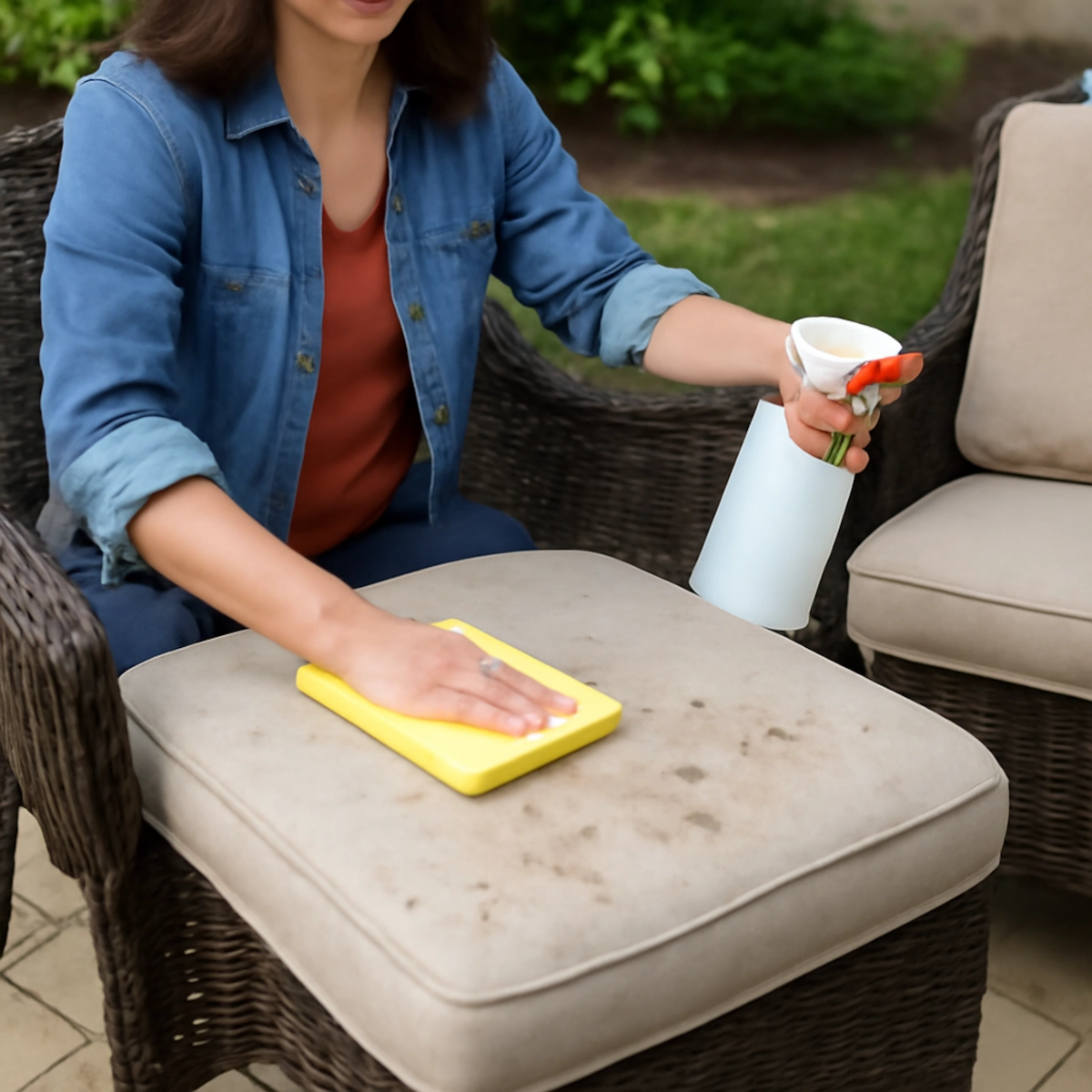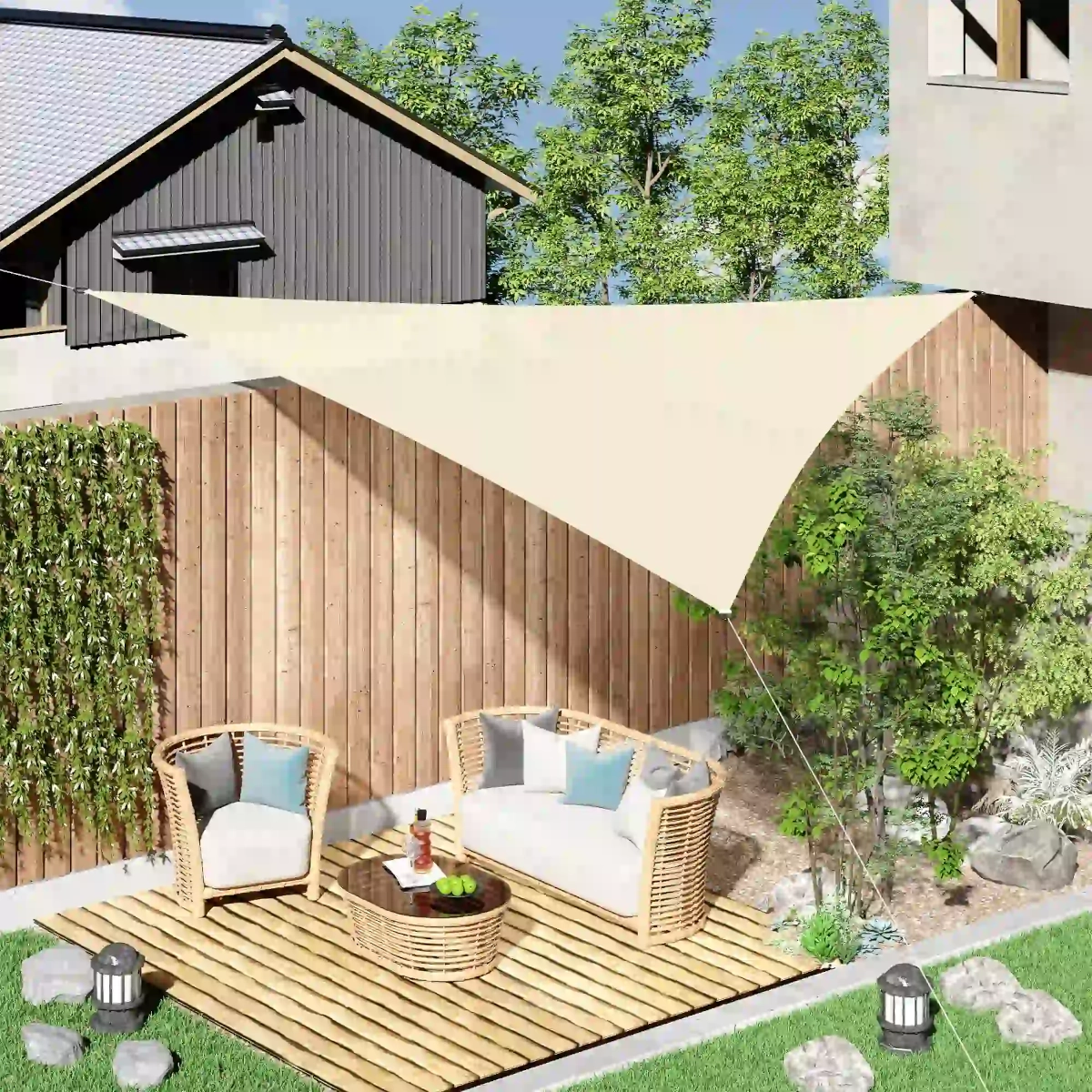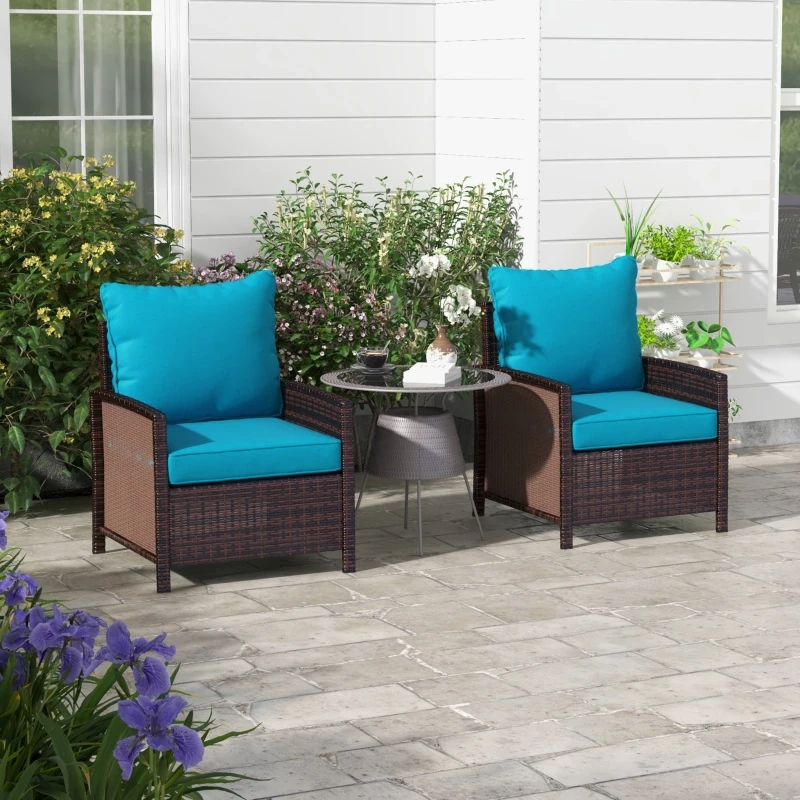1. Why Triangular Shade Sails Are Ideal for Maximum Shade Coverage
The Benefits of Triangular Shade Sails
Triangular shade sails are the most popular option for both residential and commercial spaces. Their unique shape allows them to fit snugly into corners or between structures, offering an efficient and stylish way to block the sun. They provide excellent tensioning and can be easily adjusted to suit the needs of the space.
- Versatility: Perfect for smaller or irregularly shaped areas, triangular sails can be adapted to fit unique spaces.
- Easy to Tension: The three anchor points make it easier to apply tension, ensuring the sail stays taut and doesn’t sag.

Example: The Outsunny Triangle 10′ x 10′ x 10′ Outdoor Sun Shade Sail is a perfect example of a triangular sail offering excellent sun protection. Its high-density polyethylene (HDPE) fabric blocks harmful UV rays while maintaining airflow underneath, providing a cooler space to relax.
2. How to Position Your Shade Sail for the Best Coverage
Step 1: Identify the Right Location

The first step in positioning your shade sail is determining where you need shade. Measure the area you want to cover, considering both the location and the path of the sun. This will help you figure out the best angle for maximum coverage throughout the day.
- Consider Sun Movement: Position your sail to block the sun during the hottest times of the day, usually between 11 a.m. and 3 p.m.
- Account for Space: Choose a location that allows you to create the necessary tension for the sail. Avoid installing the sail too low, as it could sag and reduce effectiveness.
Tip: If you’re unsure about where to place your sail, try using a temporary setup to visualize the sun’s movement and the shade provided at different times of the day.

Step 2: Choose Your Anchor Points
Your anchor points are critical for keeping the shade sail in place. Common options include sturdy trees, walls, or posts. If you’re installing a sail over a deck or patio, you may need to install additional poles to create secure attachment points.
- Use Strong Structures: Ensure that your anchor points are stable and can handle the tension of the sail.
- Height Variation: Installing the sail at varying heights will create the proper tension and also help with rainwater drainage.

Example: If you don’t have sufficient posts or walls for anchoring, you can use the Outsunny Sun Sail Shade Support Pole. This adjustable pole allows you to install a shade sail without relying on existing structures.
Step 3: Install Your Shade Sail at the Right Angle

The angle at which you install your shade sail can significantly affect the coverage. For maximum shade, position the sail at a slight tilt to allow water to drain off easily during rain.
- Create Proper Tension: The sail should be taut but not over-stretched. Apply tension to all corners for uniform coverage.
- Angle for Rain Drainage: A slight tilt ensures that rainwater doesn’t pool in the middle of the sail.
Tip: When installing, use ropes or carabiners to secure the D-rings at the corners of the sail to your anchor points. This will allow for easier adjustments over time.
3. Durability and Material Choices for Triangular Shade Sails
What Materials Make Triangular Shade Sails Durable?
High-quality shade sails are made from durable materials like HDPE or polyethylene, both of which offer UV protection and resist fading. These materials are ideal for outdoor use, withstanding harsh weather conditions, rain, and sun exposure.
- HDPE Fabric: Offers excellent UV-blocking properties, which help keep the shaded area cooler.
- Polyethylene: Known for being weather-resistant and long-lasting, this material provides both durability and strength.

Example: Canopy Sun Sail Shade Garden Cover UV Protector Outdoor Patio Lawn Shelter is crafted from HDPE material, making it UV-resistant and breathable, providing you with long-lasting protection from the sun while promoting airflow underneath.
How the Material Impacts Longevity
The longevity of your shade sail is directly tied to the material’s quality. High-density polyethylene, for example, can last for many years with minimal maintenance, even in areas with intense sun exposure.
- Resistant to Fading: HDPE and polyethylene materials resist fading from UV rays, ensuring the shade sail maintains its appearance over time.
- Weather-Resistant: These materials are designed to withstand outdoor conditions, including wind and rain.
4. Cost Considerations: Affordable Shade Protection
Are Triangular Shade Sails Cost-Effective?
Triangular shade sails are often more affordable than other types of shade structures, like pergolas or gazebos. Their simpler design and smaller size make them a cost-effective solution for providing sun protection.
- Lower Material Costs: Triangular sails require less fabric compared to larger square or rectangular designs, reducing production costs.
- DIY Installation: The ease of installation means you can often install your shade sail yourself, saving money on labor costs.

Example: Triangle 10′ Canopy Sun Sail Shade Garden Cover offers a highly affordable option for shading a small patio or garden without breaking the bank.
Installation and Maintenance Costs
Installation costs for triangular shade sails are relatively low, especially if you choose to install them yourself. Maintenance is minimal as well, with occasional cleaning and checks for wear being the primary tasks.
- Affordable Setup: Installing a triangular sail is simple and doesn’t require significant investment in equipment.
- Long-Term Savings: With proper care, your shade sail can last for many years, providing you with long-term value.
5. Customizing Your Triangular Shade Sail: Color and Size Options
Personalizing Your Shade Sail
Triangular shade sails are available in a variety of colors, sizes, and materials, allowing you to customize them to suit your outdoor space’s aesthetic. Whether you prefer neutral tones like cream and grey or bolder colors, there’s a shade sail to match your design.
- Color Choices: Opt for colors that complement your outdoor décor. Neutral tones like grey and cream blend well with most settings, while vibrant colors can make a statement.
- Size Options: Triangular sails come in a variety of sizes, from small corner sails to larger designs for bigger spaces.

Example: The Outsunny Square 12’ Canopy Sun Sail Shade is another option available in multiple colors, allowing you to find the perfect match for your outdoor design.
Design Ideas
- Mix and Match: Combine triangular sails in different colors to create a dynamic design.
- Create Layers: For a more complex look, layer triangular sails at different heights and angles to maximize coverage and visual appeal.
6. How to Anchor and Secure Your Shade Sail

Anchoring the Shade Sail
Securing your shade sail properly is crucial for maintaining its performance. The corners of the sail should be anchored to strong, stable structures to ensure that it stays in place and provides adequate sun protection.
- Use Strong Anchor Points: Trees, posts, and walls are all good options for anchoring your sail. If these aren’t available, you can use adjustable poles like Sun Sail Shade Support Pole for a sturdy, freestanding installation.
- Adjust the Tension: Make sure that each corner is tightly secured and that the sail is taut to avoid sagging.
How to Position the Anchors
To achieve the best coverage, position your anchors at different heights. The difference in height will create the necessary tension and also ensure that rainwater drains off effectively.
- Use D-Rings for Easy Adjustment: Attach the sail to the anchors using durable D-rings, which can be easily adjusted to maintain proper tension.
7. Maximizing Shade Coverage with Multiple Triangular Shade Sails
Layering Triangular Shade Sails for Larger Spaces
For larger areas, layering multiple triangular shade sails can create expansive coverage while maintaining a stylish, modern look. This method provides additional shade and can help block the sun from different angles.
- Combine Different Sizes: Use different sizes of sails to cover various areas, ensuring full coverage and a uniform look.
- Vary the Angles: Adjust the angles of each sail to block the sun at different times of the day.

Example: If you’re creating shade for a large garden, consider using the Outsunny Triangle Sun Shade Sail Top Cover Fabric Outdoor Shelter in combination with other triangular sails for a customized setup.
8. Maintenance and Care for Triangular Shade Sails
Keeping Your Shade Sail in Good Condition
To ensure your shade sail lasts for years, it’s essential to perform regular maintenance. Cleaning, inspecting, and re-tensioning your sail will keep it looking great and functioning properly.
- Wash Regularly: Clean the sail with mild detergent and water to remove dirt and debris.
- Inspect for Wear: Regularly check for any signs of wear, especially after storms or high winds.
Seasonal Care Tips
- Store During Winter: If you live in an area with harsh winters, consider removing and storing your shade sail to prevent damage from snow or ice.
- Re-tension as Needed: Over time, the sail may loosen. Re-tension it to maintain its effectiveness.
FAQs
1. Why is my shade sail sagging, and how can I fix it?
A sagging shade sail typically results from insufficient tension or poorly positioned anchor points. To correct this, make sure all corners are tightly secured using durable tensioning tools like turnbuckles or ropes. Also, install the sail at a slight angle to allow water runoff and maintain a firm, taut appearance.
2. Can I use existing trees or walls to anchor my shade sail?
Yes, provided they are stable and strong enough to support the tension. Mature trees with thick trunks and solid masonry walls work well. If these are not available, adjustable support poles such as the Outsunny Sun Sail Shade Support Pole offer a reliable alternative for safe installation.
3. How do I know where to install my shade sail for the most sun protection?
Evaluate the movement of sunlight across your outdoor space, especially between 11 a.m. and 3 p.m. when sun exposure is highest. Position your sail to provide shade during these hours. To be sure, consider doing a temporary setup to observe shading before finalizing anchor locations.
4. Are triangular shade sails really better than square ones?
Triangular shade sails offer more flexibility for compact or irregular areas. With just three anchor points, they are easier to install and tension evenly. They’re also less prone to sagging and can be layered at various angles to enhance both coverage and visual appeal.
5. What should I look for in a shade sail to handle Canadian weather?
Choose materials like high-density polyethylene (HDPE) or UV-treated polyethylene for resistance to fading and weather damage. These fabrics are breathable and ideal for summer conditions. Ensure the sail is angled for rainwater drainage and remove it during winter months to prevent damage from snow and ice.














